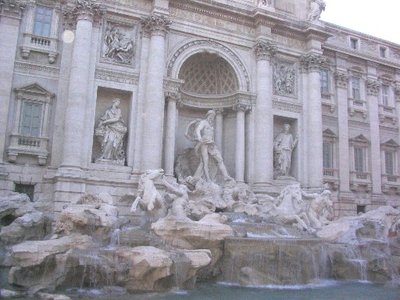Trevi Fountain
|
|
The Trevi Fountain (in Italian, Fontana di Trevi) is the largest and most ambitious of the Baroque fountains of Rome.
The fountain at the juncture of three roads (tre vie) marks the terminal point of the Aqua Virgo (in Italian: Acqua Vergine), one of the ancient aqueducts that supplied water to Rome. In 19 BC, supposedly with the help of a virgin, Roman technicians located a source of pure water only 14 miles (22 km) from the city. This Aqua Virgo was carried over Rome's shortest aqueduct directly to the Baths of Agrippa and served Rome for more than four hundred years. The "coup de grace" for the urban life of late classical Rome came when the Goth besiegers broke the aqueducts. Medieval Romans were reduced to polluted wells and the dangerous water of the Tiber, which was also used as a sewer.
The Roman custom of building a handsome fountain at the endpoint of an aqueduct that brought water to Rome was revived in the 15th century, with the Renaissance. In 1453, Pope Nicholas V finished mending the Aqua Vergine aqueduct and built a simple basin, designed by the humanist architect Leon Battista Alberti, to herald the water's arrival.
In 1629, Pope Urban VIII, finding the earlier fountain insufficiently dramatic, asked Bernini to do some drawings for it, but when the Pope died the project was abandoned. Bernini's lasting contribution was to resite the fountain from the other side of the square to face the Quirinal Palace (so the Pope could look down and enjoy it too). Though Bernini's project was torn down for Salvi's fountain, there are many Bernini touches in the fountain as it was built.
Competitions had become the rage during the Renaissance and Baroque periods to redesign buildings, fountains, and even the Spanish Steps. In 1730, Pope Clement XII organized another contest, which Nicola Salvi actually lost — but was given the job anyway. Work began in 1732 and was finished in 1762, long after Clement's death, when Pietro Bracci's 'Neptune' was set in the central niche (illustration, left). Taming of the waters is the theme of the gigantic scheme that tumbles forward, mixing water and rockwork, and filling the small square. Tritons guide Neptune's shell chariot, taming seahorses (hippocamps).
The backdrop for the fountain is the Palazzo Poli, given a new facade with a giant order of Corinthian pilasters that link the two main stories. In the center is superimposed a robustly modelled triumphal arch. The center niche or exedra framing Neptune has free-standing columns for maximal light-and-shade. In the niches flanking Neptune, Abundance spills water from her urn and Salubrity holds a cup from which a snake drinks. Above, bas reliefs illustrate the Roman origin of the aqueducts.
The tritons and horses provide symmetrical balance, with the maximum contrast in their mood and poses (by 1730, the rococo is already in full bloom in France and Germany).
TreviFountainFromLeftSide.jpg
Nicola Salvi died in 1751, with his work half-finished, but before he went he made sure a stubborn barber's unsightly sign would not spoil the ensemble, hiding it behind a sculpted vase. The Trevi Fountain was finished in 1762 by Giuseppe Pannini, who substituted the present bland allegories for planned sculptures of Agrippa and "Trivia", the Roman virgin.
The fountain was refurbished in 1998; the stonework was scrubbed and the fountain provided with recirculating pumps and oxidizers.
Trivia
The Fontana di Trevi is the 'Three Coins in the Fountain' fountain, the one that drenched Anita Ekberg in Federico Fellini's La Dolce Vita. Among those who are unaware that the "three coins' were thrown by three indiviuals, a current legend is reported that it is lucky to throw coins with one's right hand over one's right shoulder into the Trevi Fountain. Throwing one coin in will ensure that the thrower will return to Rome. Throwing two coins ensures that the thrower will fall in love with a beautiful Roman girl (or handsome boy), and throwing three coins now ensures that the thrower will marry that girl or boy in Rome.
External link
- Trevi Fountain (http://www.compart-multimedia.com/virtuale/us/roma/trevi.htm) Virtual 360° panorama and a beautiful photo gallery.
- Engravings of the fountain's more modest predecessor. (http://www2.siba.fi/~kkoskim//rooma/pages/FALD325B.HTM)de:Trevi-Brunnen
fr:Fontaine de Trevi it:Fontana di Trevi he:מזרקת טרבי nl:Trevifontein ja:トレヴィの泉 pl:Fontanna di Trevi sv:Fontana di Trevi

